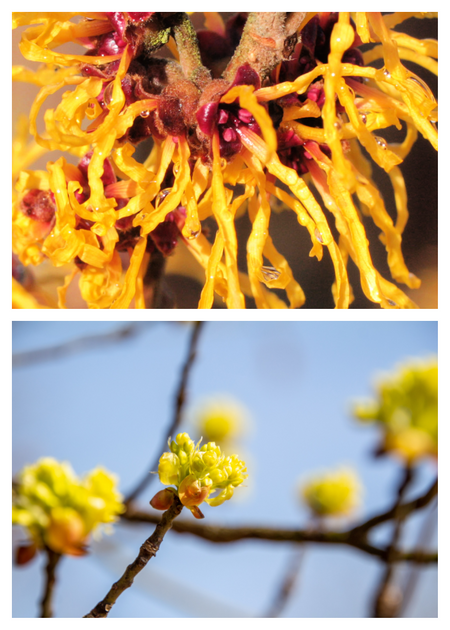Witch Hazel

Scientific Name: Hamamelis virginiana
Common Name: Witch hazel, common witch hazel, American witch hazel, witchhazel
Plant Family: Hamamelidaceae (Witch-hazel family)
Etymology: Hamamelis comes from the Greek words, meaning “fruit” and “at the same time,” referring to the shrub’s unique feature of producing flowers as the previous year’s capsules continue to ripen. The common name “witch” may allude to the use of the flexible branches as dowsing or “witching” rods for water.
Parts Used: bark, leaves, twigs
Season: spring, summer, fall
Indigenous Uses
Witch hazel was primarily used for medicinal purposes. The bark was combined with spicebush and Virginia pine needles as a tea for fevers. As a standalone tea it treated sore throat, colds, and tuberculosis and was used to bathe sores and skinned places. A decoction was used for muscular aches and bruises. The bruised leaves were rubbed on scratches. It made an excellent astringent. As a craft product, early colonial documents mention witch hazel as one of the better bow woods.
Contemporary Medicinal Uses
Topically the bruised or mashed leaves can be applied for the astringent and drawing effect on swellings, tumors, stings, and venomous bites. Witch hazel extract is commonly used to cool and shrink inflamed tissues. Modern herbalists use witch hazel as a decoction or tincture as an anti-inflammatory hemostatic for internal bleeding, and to support treatment of diarrhea and dysentery.
Caution: when consumed internally, the concentrated tannins in witch hazel bark can cause stomach upset and stress the liver.

This project was made possible by a grant from Maryland Humanities, with funding received from the Maryland Historical Trust in the Maryland Department of Planning. Maryland Humanities’ Grants Program is also supported by the National Endowment for the Humanities and private funders. Any views, findings, conclusions, or recommendations expressed on this website do not necessarily represent those of Maryland Humanities, Maryland Historical Trust, Maryland Department of Planning, or National Endowment for the Humanities.

